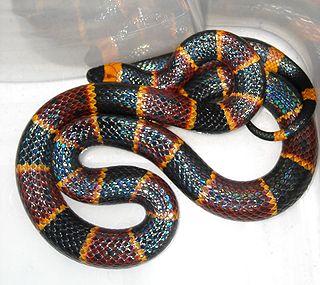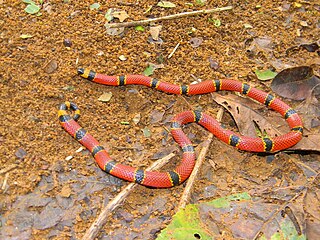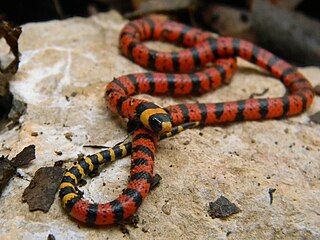
Kingsnakes are colubrid New World members of the genus Lampropeltis, which includes 26 species. Among these, about 45 subspecies are recognized. They are nonvenomous and ophiophagous in diet.

The scarlet kingsnake or scarlet milk snake is a species of kingsnake found in the southeastern and eastern portions of the United States. Like all kingsnakes, they are nonvenomous. They are found in pine flatwoods, hydric hammocks, pine savannas, mesic pine-oak forests, prairies, cultivated fields, and a variety of suburban habitats; not unusually, people find scarlet kingsnakes in their swimming pools, especially during the spring. Until recently, and for much of the 20th century, scarlet kingsnakes were considered a subspecies of the milk snake; however, Pyron and Bubrink demonstrated the phylogenetic distinction of this species and its closer relationship to the mountain kingsnakes of the southwestern United States. These largely fossorial snakes are the smallest of all the species within the genus Lampropeltis, usually ranging from 40 to 50 cm at maturity. The maximum recorded length is in Jonesboro, AR 76.2 cm (30.0 in). Hatchlings range in size from 8 to 18 cm .

Coral snakes are a large group of elapid snakes that can be divided into two distinct groups, the Old World coral snakes and New World coral snakes. There are 16 species of Old World coral snakes, in three genera, and over 65 recognized species of New World coral snakes, in two genera. Genetic studies have found that the most basal lineages have origins in Asia, suggesting that the group originated in the Old World. While new world species of both genera are venomous, their bites are seldom lethal; only two confirmed fatalities have been documented in the past 100 years from the genus Micrurus. Meanwhile, snakes of the genus Micruroides have never caused a medically significant bite.

Micrurus is a genus of venomous coral snakes of the family Elapidae.

Carphophis is a genus of small colubrid snakes endemic to the United States. The genus consists of two species, one of which has two subspecies.

Micrurus tener, commonly known as the Texas coral snake, is a species of venomous snake in the family Elapidae. The species is native to the southern United States and adjacent northeastern and central Mexico. Five subspecies are recognized as being valid, including the nominotypical subspecies, Micrurus tener tener, which is found in both the US and Mexico, and is also commonly known as the Texas coral snake. The species Micrurus tener was once considered to be a subspecies of the eastern coral snake.

Rhinocheilus lecontei tessellatus is a subspecies of nonvenomous colubrid snake, which is native to the western United States and northern Mexico.

Micrurus fulvius, commonly known as the eastern coral snake, common coral snake, American cobra, and more, is a species of highly venomous coral snake in the family Elapidae. The species is endemic to the southeastern United States. It should not be confused with the scarlet snake or scarlet kingsnake, which are harmless mimics. No subspecies are currently recognized.

Sonora palarostris, commonly known as the Sonoran shovelnose snake, is a species of small nonvenomous colubrid which is a native of the Sonoran Desert in North America.

Micrurus hemprichii, commonly known as Hemprichi's coral snake, is a species of venomous coral snake in the family Elapidae from South America.

Micrurus nigrocinctus, commonly known as the Central American coral snake, is a species of a highly venomous snake in the family Elapidae. The species is endemic to Latin America from southern Mexico, Central America, to north Colombia. There are six recognized subspecies, including the nominate subspecies described here.
Micrurus stuarti is a species of venomous snake in the family Elapidae. The species is endemic to Guatemala. There are no recognized subspecies.

Micrurus browni, commonly known as Brown's coral snake, is a species of venomous snake in the family Elapidae. The species is native to Guatemala and southwestern Mexico. There are three recognized subspecies, including the nominate subspecies described here.
Bogert's coral snake is a species of venomous snake in the family Elapidae. The species is endemic to southern Mexico.

Micrurus lemniscatus, commonly known as the South American coral snake, is a species of venomous snake in the family Elapidae. The species is endemic to South America.

Micrurus diastema, commonly known as the variable coral snake, is a species of venomous snake in the family Elapidae. The species is endemic to southeastern Mexico and northern Central America. There are seven recognized subspecies.
Micrurus nigrocinctus babaspul, or the babaspul, is a subspecies of Micrurus nigrocinctus, commonly known as the Central American coral snake. M. n. babaspul is a venomous elapid from Big Corn Island, Nicaragua. According to O'Shea (2008) this is an endangered subspecies, and the subspecies may even be extinct.
Jānis Arnolds Roze, born in Latvia in 1926, is a herpetologist and Professor of Biology Emeritus of City College and Graduate School of the City University of New York. He was professionally associated with the American Museum of Natural History and the United Nations. A founder of the International Center for Integrative Studies, he published several books and narrated several videos on Creative Evolution. He co-edited What Does it Mean to Be Human.

Micrurus averyi, also known commonly as Avery's coral snake and the black-headed coral snake, is a species of coral snake, a venomous snake in the genus Micrurus of the family Elapidae. The species is indigenous to northern South America.
Micrurus diana, also known commonly as Diana's coral snake, is a species of venomous snake in the family Elapidae. The species is native to South America.


















